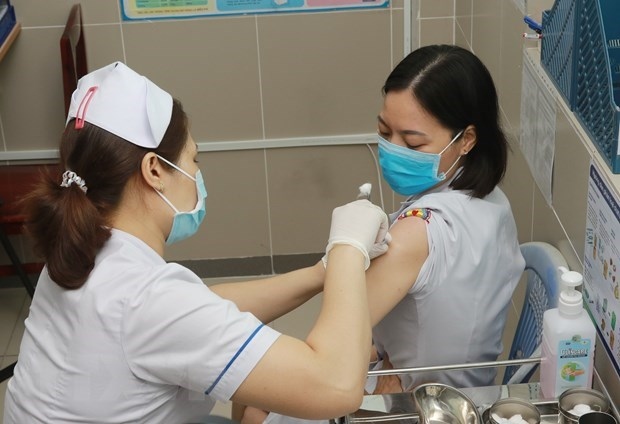
ILO calls for resilient occupational safety, health system for future emergencies
Latest
 |
| A medical worker is vaccinated against COVID-19. (Photo: VNA) |
Rising concerns over occupational safety and health
Since the COVID-19 pandemic emerged, workers in specific sectors, such as emergency, health and social care, have become particularly vulnerable to the risk of infection, says the ILO in a report released on World Day for Safety and Health at Work.
Some 7,000 health workers have died since the outbreak of the crisis, while 136 million health and social care workers are at risk of contracting COVID-19 through work, according to data cited in the report “Anticipate, prepare and respond to crises: Invest now in resilient OSH systems.”
The pressure and risks facing health workers during the pandemic have also taken a toll on their mental health. One in five healthcare workers globally have reported depression and anxiety symptoms.
As well as the health and care sectors, many other workplaces have been sources of COVID-19 outbreaks, when staff are in closed environments or spend time in close proximity with each other, including in shared accommodation or transport.
In analyzing the health concerns arising from the dramatic increase in teleworking during the pandemic, the report says that while teleworking has been essential in limiting the spread of the virus, maintaining jobs and business continuity and giving workers increased flexibility, it has also blurred the lines between work and private life.
Sixty-five percent of enterprises surveyed by the ILO and the G20 OSH Network reported that worker morale has been difficult to sustain while teleworking.
The report says small and micro-sized enterprises have often found it hard to meet official OSH requirements because many have lacked the resources to adapt to the threats posed by the pandemic.
In the informal economy, many of the 1.6 billion workers, especially in developing countries, have continued working despite lockdowns, restrictions on movement and social interaction, and other measures. This has put them at high risk of catching the virus, yet most do not have access to basic social protection, such as sick leave or sick pay.
Crisis preparedness and response
The report examines risk prevention and management relating to the pandemic, and analyses other health and safety risks associated with the changing work arrangements arising from virus control measures.
It outlines the critical roles played during the pandemic by occupational safety and health regulatory frameworks and institutions, compliance mechanisms, health and advisory services, data, research and training.
This will require investment in OSH infrastructure and integrating it into overall national crisis emergency preparedness and response plans, so that workers’ safety and health are protected, and the business continuity of enterprises is supported.
“There could be no clearer demonstration of the importance of a strong, resilient, occupational safety and health environment,” said ILO Director-General, Guy Ryder. “Recovery and prevention will require better national policies, institutional and regulatory frameworks, properly integrated into crisis response frameworks.”
International labour standards (ILS) offer specific guidance on how to respond to these challenges, thereby reducing the risk of virus transmission in the workplace, the report says. They provide tools to implement OSH measures and to ensure that workers, employers and governments can maintain decent work, while adjusting to the socio-economic consequences of the pandemic.
ILS also encourages social dialogue as the best way to ensure that procedures and protocols are effectively implemented and accepted.
In Vietnam, May is designated as the action month for occupational safety and health marked nationwide annually. This year, the month-long campaign will be held under the theme of strengthening evaluation and control of occupational safety and health-associated risks.
In response to this, authorities will inspect COVID-19 preventive measures at enterprises and industrial parks across 13 cities and provinces, and examines several businesses and healthcare unites on how they ward off the coronavirus, ensure occupational safety and health, and prevent occupational diseases.





















